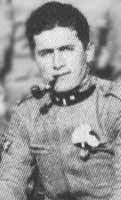Alberto Tomba – Italy’s greatest skier
Playboy showman who won three Olympic golds
Italy’s greatest alpine ski racer, Alberto Tomba, was born on this day in 1966 in San Lazzaro di Savena, a town in Emilia-Romagna that now forms part of the metropolitan city of Bologna. Tomba – popularly known as ‘Tomba la Bomba’ – won three Olympic gold medals, two World Championships and won no fewer than nine titles in thirteen World Cup seasons, between 1986 and 1998. The only other Italian Alpine skiers with comparable records are Gustav Thoni, who won two Olympic golds and four World Championships in the 1970s, and Deborah Compagnoni, who won three golds at both the Olympics and the World Championships between 1992 and 1998. Thoni would later be a member of Tomba’s coaching team. Tomba had showmanship to match his talent on the slopes. Always eager to seek out the most chic nightclubs wherever he was competing, he would drive around the centre of Bologna in an open-topped Ferrari, flaunting both his wealth and his fame. At his peak, he would arrive with his entourage in the exclusive ski resort at Aspen, Colorado to hold open house at his rented chalet on Buttermilk Mountain. Read more…
________________________________________________________________
Gianni Brera - football journalist
Outspoken writer who embellished Italian language
Italy's football world lost one of its most influential personalities on this day in 1992 when a car crash near the town of Codogno in Lombardy claimed the life of the journalist Gianni Brera. Brera, who was 73, had enjoyed a long and often controversial career in which his writing was famous not only for its literary quality but for his outspoken views. He could be savage in his criticisms of players and allowed reputations to count for nothing. His long-running feud with Gianni Rivera, the AC Milan midfielder regarded by many as one of Italian football's all-time greats, in some ways defined his career. Yet the positions he occupied in Italian football journalism gained him enormous respect. He rose to be editor-in-chief of La Gazzetta dello Sport, Italy's biggest sports newspaper, before he was 30 and went on to write for Il Giorno, Il Giornale and La Repubblica among the country's heavyweight news dailies. The intellectual La Repubblica for many years considered sport to be too trivial to be worthy of coverage, an attitude that persisted even through the 1970s. But the style and innovative brilliance of Brera's writing was a major factor in persuading them to drop their stance. Read more…
________________________________________________________________
Italo Svevo - writer
Author who became the main character in somebody else’s novel
The novelist Italo Svevo was born Aron Ettore Schmitz on this day in 1861 in Trieste, which was then part of the Austrian Empire. Schmitz took on the pseudonym, Italo Svevo, after writing his novel La Coscienza di Zeno - Zeno’s Conscience. The novelist himself then became the inspiration for a fictional protagonist in a book by someone else. James Joyce, who was working in Trieste at the time, modelled the main character in Ulysses, Leopold Bloom, on his friend Svevo. Svevo’s own novel, which revealed his deep interest in the theories of Sigmund Freud, received little interest at the time and might have sunk without trace if it had not been for the encouragement of Joyce, who regarded him as a neglected writer. Joyce helped Svevo get the novel translated into French and, after the translated version was highly praised, the Italian critics discovered it. Svevo always spoke Italian as a second language because he usually spoke the dialect of Trieste where his novel is set and the story never looks outside the narrow confines of Trieste. In the novel the main character seeks psychoanalysis to discover why he is addicted to nicotine. Read more…
_________________________________________________________________
Giulio Ricordi - music publisher
Entrepreneur who ‘discovered’ the great Giacomo Puccini
Giulio Ricordi, who ran the Casa Ricordi publishing house during its peak years in the late 19th and early 20th centuries and launched the career of the brilliant opera composer Giacomo Puccini, was born on this day in 1840 in Milan. Casa Ricordi was founded by Giulio’s grandfather Giovanni in 1808 and remained in the family when Giovanni died in 1853 and his son, Tito - Giulio's father - took the helm. Giulio became involved in 1863 after a distinguished military career in the special infantry corps known as the Bersaglieri. He had enrolled as a volunteer with the outbreak of the Second Italian War of Independence in 1859. He took part in the Siege of Gaeta and, after receiving a medal for military valour, was promoted to lieutenant. During breaks in military activity, Giulio, a keen composer from an early age under the pseudonym of Jules Burgmein, wrote pieces of music, one of which was intended as a national anthem dedicated to Victor Emmanuel II of Savoy, but which was instead adopted as the anthem of the Bersaglieri. He left military service after his father, who had nurtured the career of the composer Giuseppe Verdi. Read more…
Home

















